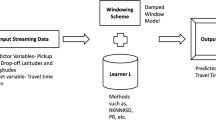Abstract
With the development of urban transportation networks, the flow of people in cities generally shows the characteristics of concentration, periodicity and irregularity, and a typical example is rush hour. For most existing taxi-hailing apps, users frequently queue up for a relatively long time during rush hour and may even fail to get orders taken due to various factors. To solve this problem, we propose a users’ departure time prediction model based on Light Gradient Boosting Machine (TP-LightGBM), which will remind users to book taxis before their journeys. As we know, TP-LightGBM may be the first model for departure time prediction. We uncover that travel behavior patterns vary under different external conditions through statistics and analysis of users’ historical orders from multiple perspectives. Furthermore, we extract multiple features from these orders and select the favorable features by calculating their information gain as the input of TP-LightGBM to predict users’ departure time. Therefore, our model can provide users with the recommendations of the best departure time if they need them. The final experimental results on our datasets indicate that TP-LightGBM has more excellent performance with great stability in predicting user departure time than other baseline models.
Access this chapter
Tax calculation will be finalised at checkout
Purchases are for personal use only
Similar content being viewed by others
References
Van der Aalst, W.M., Schonenberg, M.H., Song, M.: Time prediction based on process mining. Inf. Syst. 36(2), 450–475 (2011)
Breiman, L., Friedman, J.H., Olshen, R.A., Stone, C.J.: Classification and Regression Trees. Routledge, Milton Park (2017)
Chen, M., Chien, S.I.: Dynamic freeway travel-time prediction with probe vehicle data: link based versus path based. Transp. Res. Rec. 1768(1), 157–161 (2001)
Chen, M., Liu, X., **a, J., Chien, S.I.: A dynamic bus-arrival time prediction model based on APC data. Comput.-Aided Civil Infrastruct. Eng. 19(5), 364–376 (2004)
Cheng, J., Li, G., Chen, X.: Research on travel time prediction model of freeway based on gradient boosting decision tree. IEEE Access 7, 7466–7480 (2018)
Chien, S.I.J., Ding, Y., Wei, C.: Dynamic bus arrival time prediction with artificial neural networks. J. Transp. Eng. 128(5), 429–438 (2002)
Chien, S.I.J., Kuchipudi, C.M.: Dynamic travel time prediction with real-time and historic data. J. Transp. Eng. 129(6), 608–616 (2003)
Ding, C., Wang, D., Ma, X., Li, H.: Predicting short-term subway ridership and prioritizing its influential factors using gradient boosting decision trees. Sustainability 8(11), 1100 (2016)
Duan, Y., Yisheng, L., Wang, F.Y.: Travel time prediction with LSTM neural network. In: 2016 IEEE 19th International Conference on Intelligent Transportation Systems (ITSC), pp. 1053–1058. IEEE (2016)
Fei, X., Lu, C.C., Liu, K.: A Bayesian dynamic linear model approach for real-time short-term freeway travel time prediction. Transp. Res. Part C: Emerg. Technol. 19(6), 1306–1318 (2011)
Friedman, J.H.: Greedy function approximation: a gradient boosting machine. Ann. Stat. 1189–1232 (2001)
Ke, G., et al.: LightGBM: a highly efficient gradient boosting decision tree. In: Advances in Neural Information Processing Systems, vol. 30 (2017)
Kwon, J., Coifman, B., Bickel, P.: Day-to-day travel-time trends and travel-time prediction from loop-detector data. Transp. Res. Rec. 1717(1), 120–129 (2000)
Quinlan, J.R.: Induction of decision trees. Mach. Learn. 1(1), 81–106 (1986)
Quinlan, J.R.: C4. 5: programming for machine learning. Morgan Kauffmann 38(48), 49 (1993)
Rao, H., et al.: Feature selection based on artificial bee colony and gradient boosting decision tree. Appl. Soft Comput. 74, 634–642 (2019)
Sun, R., Wang, G., Zhang, W., Hsu, L.T., Ochieng, W.Y.: A gradient boosting decision tree based GPS signal reception classification algorithm. Appl. Soft Comput. 86, 105942 (2020)
Xu, J., Rahmatizadeh, R., Bölöni, L., Turgut, D.: Real-time prediction of taxi demand using recurrent neural networks. IEEE Trans. Intell. Transp. Syst. 19(8), 2572–2581 (2018)
Yang, L., Zhang, X., Liang, S., Yao, Y., Jia, K., Jia, A.: Estimating surface downward shortwave radiation over china based on the gradient boosting decision tree method. Remote Sens. 10(2), 185 (2018)
Zhang, X., Rice, J.A.: Short-term travel time prediction. Trans. Res. Part C: Emerg. Technol. 11(3–4), 187–210 (2003)
Zhang, Y., Haghani, A.: A gradient boosting method to improve travel time prediction. Transp. Res. Part C: Emerg. Technol. 58, 308–324 (2015)
Acknowledgment
We are grateful to anonymous reviewers for their helpful comments. This work is partially supported by the National Key Research and Development Program of China under Grant No. 2018AAA0101100.
Author information
Authors and Affiliations
Corresponding author
Editor information
Editors and Affiliations
Rights and permissions
Copyright information
© 2022 The Author(s), under exclusive license to Springer Nature Switzerland AG
About this paper
Cite this paper
Zhang, L. et al. (2022). Users’ Departure Time Prediction Based on Light Gradient Boosting Decision Tree. In: Wang, L., Segal, M., Chen, J., Qiu, T. (eds) Wireless Algorithms, Systems, and Applications. WASA 2022. Lecture Notes in Computer Science, vol 13472. Springer, Cham. https://doi.org/10.1007/978-3-031-19214-2_50
Download citation
DOI: https://doi.org/10.1007/978-3-031-19214-2_50
Published:
Publisher Name: Springer, Cham
Print ISBN: 978-3-031-19213-5
Online ISBN: 978-3-031-19214-2
eBook Packages: Computer ScienceComputer Science (R0)




